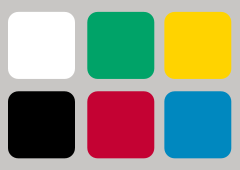- Natural Color System
-
 The NCS color model is based on the three pairs of elementary colors (white–black, green–red, and yellow–blue), as defined by color opponency. It is not possible to describe the perceptual appearance of these colors in terms of the perceptual appearance of any other color, whereas the perceptual appearance of other colors can be described in terms of these six.
The NCS color model is based on the three pairs of elementary colors (white–black, green–red, and yellow–blue), as defined by color opponency. It is not possible to describe the perceptual appearance of these colors in terms of the perceptual appearance of any other color, whereas the perceptual appearance of other colors can be described in terms of these six.
The Natural Color System (NCS) is a proprietary perceptual color model published by the Scandinavian Colour Institute (Skandinaviska Färginstitutet AB) of Stockholm, Sweden. It is based on the color opponency description of color vision, first proposed by German physiologist Ewald Hering. The system is usually used for matching colors (using printed reference cards), rather than mixing colors.
The underlying physiological mechanisms involved in color opponency include the bipolar and ganglion cells in the retina, which process the signal originated by the retinal cones before it is sent to the brain. A model like RGB describes what happens at the lower, retinal cone level, and thus is very well fitted for the task of "fooling the eye" as done by TV sets and computer displays. The NCS model, for its part, describes the organization of the color sensations as perceived at the upper, brain level, and thus is much better fitted than RGB to deal with how humans experience and describe their color sensations (hence the "natural" part of its name); but it would be useless, for example, for describing the behavior of mixing lights and pigments.
The NCS is based on the six elementary color percepts of human vision—the psychological primaries—as described by color opponency—white, black, red, yellow, green, and blue—which are difficult to define perceptually in terms of others (for example, one cannot describe color red as looking "like a yellow and magenta mixture", even though you will in fact get a red pigment by mixing yellow and magenta pigments). These six elementary colors are frequently chosen to paint educational toys, or for designs that try to appeal from their simplicity (such as the Olympic flag and the Microsoft Windows logo). All the other perceptual colors are composite perceptions that can be defined in terms of those six (for example, turquoise looks like "bluegreen", orange like "a color that is both reddish and yellowish", and brown looks like "a very dark orange", that is, like a mixture of red, yellow and black). This all means the appearance of a color can be readily predicted from its NCS notation, whereas its notation in systems such as RGB often looks unintuitive (for example, yellow does not look like "a reddish-greenish color" at all, even though the yellow on an RGB monitor is obtained by mixing red and green lights). Note also that, under normal viewing circumstances, there is no hue that must be described as a mixture of opponent hues; that is, as a hue looking "redgreen" or "yellowblue" (see note in the color opponents article).
Colors in the NCS are defined by three values, specifying the amount of blackness (darkness), chromaticity (saturation), and a percentage value between two of the colors red, yellow, green or blue (hue). The blackness and the chromaticity together add up to less than or equal to 100%—their remainder from 100%, if any, gives the amount of whiteness. The complete NCS color notations can also be tagged with a letter giving the version of the NCS color standard that was used to specify the color.
Two examples of NCS color notation—the yellow and blue shades of the Swedish flag:
- Yellow – NCS 0580-Y10R (= 5% darkness, 80% saturation, 90% yellow + 10% red = very slightly darkish mostly saturated yellow with a slight orangish tinge)
- Blue – NCS 4055-R95B (= 40% darkness, 55% saturation, 5% red + 95% blue = somewhat dark rather unsaturated blue with a very slight purplish tinge)
The NCS is represented in 19 countries and is the reference norm for color designation in Sweden (since 1979), Norway (since 1984) and Spain (since 1994). It is also one of the standards used by the International Colour Authority, a leading publisher of color trend forecasts for the interior design and textile markets.
Overview of the six base colors in Natural Color System with their equivalent in hex triplet, RGB and HSV coordinates systems.
Color Hex triplet RGB HSV White #FFFFFF (255,255,255) (-°, 0%, 100%) Black #000000 (0,0,0) (-°, -%, 0%) Green #009F6B (0, 159, 107) (160°, 100%, 63%) Red #C40233 (196,2,51) (345°, 99%, 77%) Yellow #FFD300 (255, 211, 0) (50°, 100%, 100%) Blue #0087BD (0, 135, 189) (197°, 100%, 74%) See also
- Color chart, other color systems and charts
External links
- Official NCS website
- NCS Colour Centre for the UK and Ireland (an official distributor for the NCS)
- An online NCS calculator
- RGB Browser with NCS color matching
- ToyPalette from Loo & Cox, a web application for generating color palettes from images. NCS color analysis of digital image.
Color space CIE RGB color spaces · sRGB · Adobe · Wide Gamut · ProPhoto · scRGB
YUV Other Categories:
Wikimedia Foundation. 2010.

